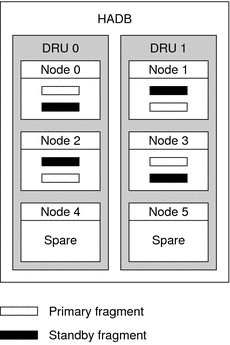HADB Server Architecture
High availability means availability despite planned outages for upgrades or unplanned outages caused by hardware or software failures. HADB is based on a simple data model and redundant, scalable, and high performance technology. HADB offers an ideal platform for delivering all types of session state persistence within a high performance enterprise application server environment.
The following figure shows the architecture of a database with four active nodes and two spare nodes. Nodes 0 and 1 are a mirror node pair, as are nodes 2 and 3.
Figure 2–1 HADB Architecture

HADB achieves high data availability through fragmentation and replication of data. All tables in the database are partitioned to create subsets of approximately the same size called fragments. Fragmentation is based on a hash function that evenly distributes the data among the nodes of the database. Each fragment is stored twice in the database, in mirror nodes. This ensures fault tolerance and fast recovery of data. In addition, if a node fails, or is shut down, a spare node can take over until the node is active again.
HADB nodes are organized into two Data Redundancy Units (DRUs), which mirror each other. Each DRU consists of half of the active and spare nodes, and contains one complete copy of the data. To ensure fault tolerance, the computers that support one DRU must be completely self-supported with respect to power (use of uninterruptible power supplies is recommended), processing units, and storage. If a power failure occurs in one DRU, the nodes in the other DRU can continue servicing requests until the power returns.
Without a session persistence mechanism, the HTTP or SFSB session state, including the passivated session state, is lost when one web or EJB container fails over to another. Use of the HADB for session persistence overcomes this situation. The HADB stores and retrieves state information in a separate but well-integrated persistent storage tier.
HADB reclaims space when session data is deleted. HADB places session data records in fixed size blocks. When all records of a block are deleted, the block is freed. Records of a block can be deleted randomly, creating holes in the block. When a new record is inserted into a block and contiguous space is needed, the holes are removed and thus the block is compacted.
This is a brief summary of the architecture. For more information, see Sun Java System Application Server Enterprise Edition 8.1 2005Q2 Deployment Planning Guide.
- © 2010, Oracle Corporation and/or its affiliates
